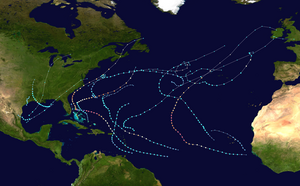
Back Atlantische Hurrikansaison 2019 German Temporada de huracanes en el Atlántico de 2019 Spanish 2019. aasta Atlandi orkaanihooaeg Estonian Vuoden 2019 Atlantin hurrikaanikausi Finnish Saison cyclonique 2019 dans l'océan Atlantique nord French 2019년 북대서양 허리케인 Korean Atlantisch orkaanseizoen 2019 Dutch Temporada de furacões no oceano Atlântico de 2019 Portuguese 2019 Atlantic hurricane season SIMPLE ฤดูพายุเฮอริเคนแอตแลนติก พ.ศ. 2562 Thai
| 2019 Atlantic hurricane season | |
|---|---|
 Season summary map | |
| Seasonal boundaries | |
| First system formed | May 20, 2019 |
| Last system dissipated | November 24, 2019 |
| Strongest storm | |
| Name | Dorian |
| • Maximum winds | 185 mph (295 km/h) (1-minute sustained) |
| • Lowest pressure | 910 mbar (hPa; 26.87 inHg) |
| Seasonal statistics | |
| Total depressions | 20 |
| Total storms | 18 |
| Hurricanes | 6 |
| Major hurricanes (Cat. 3+) | 3 |
| Total fatalities | 121 total |
| Total damage | $11.6 billion (2019 USD) |
| Related articles | |
The 2019 Atlantic hurricane season was the fourth consecutive above-average and damaging season dating back to 2016. The season featured eighteen named storms, however, many storms were weak and short-lived, especially towards the end of the season. Six of those named storms achieved hurricane status, while three intensified into major hurricanes.[nb 1] Two storms became Category 5 hurricanes, marking the fourth consecutive season with at least one Category 5 hurricane, the third consecutive season to feature at least one storm making landfall at Category 5 intensity, and the seventh on record to have multiple tropical cyclones reaching Category 5 strength. The season officially began on June 1 and ended on November 30. These dates historically describe the period each year when most tropical cyclones form in the Atlantic basin and are adopted by convention. However, tropical cyclogenesis is possible at any time of the year, as demonstrated by the formation of Subtropical Storm Andrea on May 20, making this the fifth consecutive year in which a tropical or subtropical cyclone developed outside of the official season.[2]
The season's first hurricane, Barry, formed in mid-July in the northern Gulf of Mexico and struck Louisiana. Barry caused two deaths and produced flooding in Arkansas, Alabama, Louisiana, and Mississippi, with damage totaling about $600 million (2019 USD).[nb 2] Hurricane Dorian, the most intense tropical cyclone of the season, proved to be the costliest natural disaster in the history of the Bahamas, becoming the strongest hurricane to strike the country. Overall, Dorian caused about $5.1 billion in damage and 84 fatalities, mostly in the Bahamas. The 2019 season was the record fourth consecutive season to feature at least one Category 5 hurricane. Tropical Storm Fernand left flooding in Mexico, with approximately $11.3 million in damage and one death. Hurricane Humberto produced extensive damage in Bermuda, totaling at least $25 million.
Drifting over Texas, Tropical Storm Imelda resulted in a devastating flood in the eastern portions of the state, with about $5 billion in damage and five fatalities. Lorenzo, which became the easternmost Category 5 Atlantic hurricane on record, caused 11 deaths after sinking the French tugboat Bourbon Rhode and 8 other fatalities from rough surf along the East Coast of the United States. With Dorian and Lorenzo both intensifying into Category 5 hurricanes, the season became one of seven seasons to feature multiple Category 5 hurricanes. Additionally, Tropical Storm Nestor caused a tornado outbreak across west Florida in mid-October, leaving $125 million in damage, while a car crash in South Carolina killed three people. Tropical Storm Olga caused moderate damage and heavy flooding over the central Gulf Coast and generated hurricane-force wind gusts as far north as Tennessee. The storm left one dead and around $400 million in damage. Hurricane Pablo became the easternmost hurricane formation on record, beating 2005's Hurricane Vince. The season concluded with Tropical Storm Sebastien, which became extratropical on November 24.
Most forecasting agencies projected a near-average or slightly above season, with many expecting near-normal sea surface temperatures but expressing uncertainty about the intensity of El Niño. Ultimately, activity in regards to number of named storms exceeded all forecasts, but the number of hurricanes and major hurricanes remained within the predicted range.
- ^ Saffir–Simpson Hurricane Wind Scale. National Hurricane Center (Report). Miami, Florida: National Oceanic and Atmospheric Administration. May 23, 2013. Archived from the original on January 11, 2014. Retrieved July 1, 2019.
- ^ Forbes, Alex (June 1, 2022). "No Atlantic storms develop before hurricane season for first time in seven years". Macon, Georgia: WMAZ-TV. Archived from the original on January 28, 2024. Retrieved August 12, 2022.
Cite error: There are <ref group=nb> tags on this page, but the references will not show without a {{reflist|group=nb}} template (see the help page).
© MMXXIII Rich X Search. We shall prevail. All rights reserved. Rich X Search